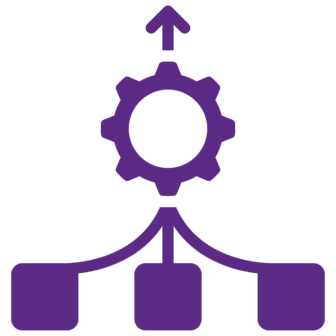While Knowledge Management (KM) is critical for organizations of every shape and size, KM is often the key to longevity and success for large enterprises that must be able to adapt to volatility and constant change. Through our partnerships with industry-leading corporations around the world, our experts at Enterprise Knowledge (EK) have found that these organizations often share common challenges that can be mediated by engaging in good KM. In this two-part blog series, I discuss six common challenges experienced by Fortune 500 and multinational organizations and offer solutions to them, providing explanations, justifications, and use cases for each.
In this Part I, I walk through sections about anticipating and reacting to change within an organization, the common dilemma of consolidating or integrating technical solutions, and the significance of prioritizing business value during strategy and design initiatives. In Part II, I will address the advantages of building to scale for technical and non-technical solutions, the benefits of engaging a diverse audience, and the importance of educating stakeholders on how to maintain solutions in the long-term. By reading this blog series you will obtain valuable best practices, real-life applications, and comprehensive solutions to common organizational challenges at large enterprises, providing you with a better understanding of how to assess the current state and maturity of your organization, and potentially even a valuable starting point for solving an existing problem that you’re experiencing.
1. Anticipate Change

Prolonged success at any large organization can be dependent on its ability to manage change. Large organizations are often in flux, and rapidly changing environments require rapidly evolving products and processes. It is key to consistently evaluate and re-evaluate your enterprise processes and organizational structure to ensure they are fulfilling the requirements of your organization and enabling employees to effectively execute their job responsibilities.
Business agility, or lack thereof, for large organizations can appear in many different forms. I recently worked with an organization that underwent a series of mergers and acquisitions, and as a result, their organizational landscape was highly siloed and fragmented. The organization was financially integrated under one name, but from a logistical and operational standpoint, business units and teams were not communicating or sharing critical information with one another. As a result, many of the same or similar processes were being executed in various locations across the enterprise without leveraging each other, and it was also very difficult to find a piece of content located in another repository. This duplication of workflows and content, as well as the lack of synergy between adjacent business units and teams, was costing the organization time and resources that could have been allocated more effectively, ultimately resulting in increased bottom-line costs.
One solution that EK recommended for this organization to combat these issues was the implementation of a KM Leadership structure to establish dedicated KM team members to initiate and guide a KM program, promoting cross-functional relationships throughout the enterprise and encouraging knowledge and information transfer. To complement the KM Leadership structure, EK also recommended a KM Governance model to mitigate risks and bad habits such as recreating pre-existing documentation or artifacts, storing content in the wrong location or tagging it incorrectly, utilizing an inaccurate or outdated piece of content, wasting hours searching for a piece of content that someone may or may not have access to, failing to update or archive obsolete content, or utilizing informal networks to access experts or colleagues.
2. Consolidate or Integrate
Maintaining too many disjointed systems can present challenges from a logistical perspective, creating confusion for users on where to store and find content, as well as how to share things across platforms. It is very common for large organizations to have an array of systems, repositories, and tools that comprise their technical stack, many of which overlap in function and purpose. It is also not uncommon for these systems to be disparate, meaning that systems cannot effectively “speak” to one another through integrations or channels. If systems are disjointed, and an organization does not possess a universal search tool that’s integrated with the necessary systems and tools, employees must often navigate through each individual repository when trying to locate a piece of content or even ask a colleague to find it for them.
An initial knee-jerk reaction may be to consolidate repetitive systems and migrate all relevant content to a single platform in order to mitigate confusion and ultimately lower overhead and subscription costs. While system consolidation is a viable solution in some use cases, it is equally important to understand that large organizations typically consist of many different employee types, teams, and business units, all of which can use different tools based on personal preferences and workflows. While this can be logistically challenging, organizations need to be extremely careful not to consolidate or remove systems that are integral to certain workflows, particularly ones inherent to creative processes that have propelled the organization to innovate and be successful within its given space. Just because an organization possesses multiple different systems that have certain core functionalities and applications in common, does not necessarily mean that these systems should all be consolidated into one.
Good KM can prevent this. A common best practice during the initiation of any technical evaluation is to engage with stakeholders from across the organization to understand their workflow priorities before removing any tools. Furthermore, one possible alternative to any sort of system consolidation is an enterprise taxonomy, or in other words, a controlled vocabulary used to describe or characterize explicit concepts of information for the purposes of capturing and managing content at an organizational level. Designing and implementing an enterprise taxonomy into prioritized repositories to universally tag content, utilized in tandem with a taxonomy management tool and an enterprise search tool, can help organizations realize and overcome their inefficiencies without having to make any major system changes or disrupt workflows.
A good example of this came during an engagement with a multinational technology firm, where one team used SharePoint as their knowledge base, and another team used an internally developed software to house their day-to-day information and content. As each team was only familiar with and had the necessary permissions to its own respective system, it was challenging to navigate another repository when working together on adjacent initiatives. The organization did not want to consolidate either system as there were viable use cases for both, and removing one would have disrupted workflows even more. Knowing this, EK proposed that the organization design and implement an enterprise taxonomy that could be integrated into the existing enterprise search tool and the prioritized repositories. This enabled employees to universally search and pull content across disparate systems, empowering them to find and leverage information significantly quicker and easier than before, enhancing both employee satisfaction and productivity.
3. Prioritize Business Value
KM success at large organizations is often defined by what tangible Return on Investment (ROI) is attained as a result of a given effort. It can be difficult to garner buy-in for KM without quantifiable metrics to support it, and when acting on a limited budget, prioritizing processes or systems that are directly tied to business outcomes and/or end-users can be a key component in the success of a given initiative. During any KM engagement, it’s important to understand and prioritize the sections of the organization that require the most immediate attention and will translate into clear, palpable ROI.
Furthermore, successful engagements that demonstrate immediate business value to an organization and its end-users can also be helpful in garnering institutional buy-in for KM. Being able to tangibly demonstrate how a KM initiative solved an existing problem, and in turn, definitively improved a business process or output, shows the concrete value of KM and incentivizes more comprehensive support for KM from across the organization.
During one recent engagement, another large technology firm was struggling with the findability, discoverability, accuracy, and relevancy of its content, and it was also seeking to lay a foundation for the future of remote work. The organization was composed of numerous different teams and business units, many of which struggled to find the data and information they needed to execute their day-to-day workflows. While the organization wanted to solve this problem at an enterprise level, they needed to prioritize sections of the organization that would provide the most immediate business value because they did not yet have the resources to address the problem enterprise-wide. EK worked with the organization in selecting which business units and/or teams could enable “quick-wins” and prioritized them when making recommendations. EK provided recommendations to the organization on three primary areas: Enterprise Search, Content Strategy, and KM Leadership and Governance. These recommendations were focused on the areas of the organization that had been mutually identified as those which will provide the most immediate value, but also provided scaling models for how to most effectively expand the solutions to the rest of the enterprise. The organization was so satisfied with our work that they re-engaged EK to begin executing the recommendations in 2023.
Conclusion
Whether you’re anticipating a major organizational change on the horizon, or planning on implementing a new strategy or solution to your environment to solve an existing problem, KM transformations can be complex and difficult to manage. If these challenges sound applicable to you or your organization, EK’s expert consultants, designers, architects, and engineers are available to assist your organization with any and all of its organizational needs.
Stay tuned for Part II where I will walk through the advantages of building to scale for technical and non-technical solutions, the benefits of engaging a diverse audience, and the importance of educating stakeholders on how to maintain solutions in the long-term.
